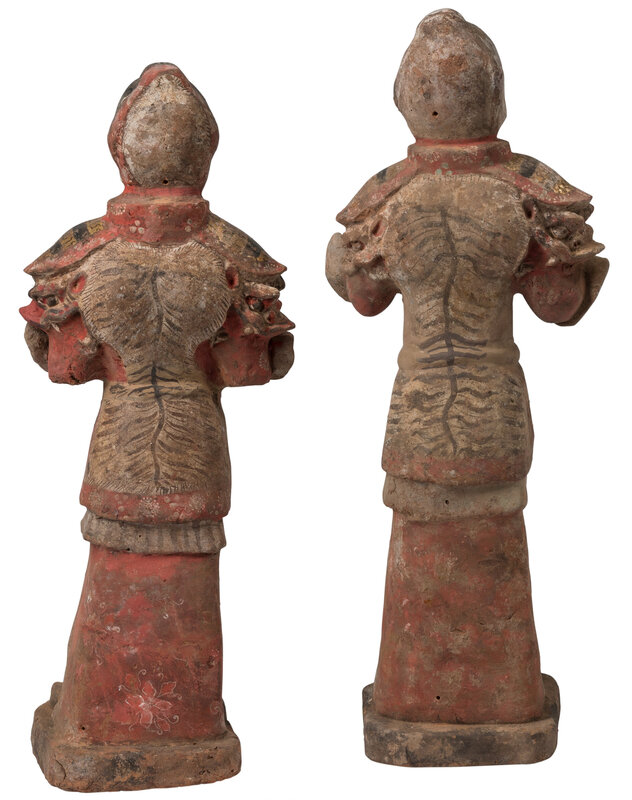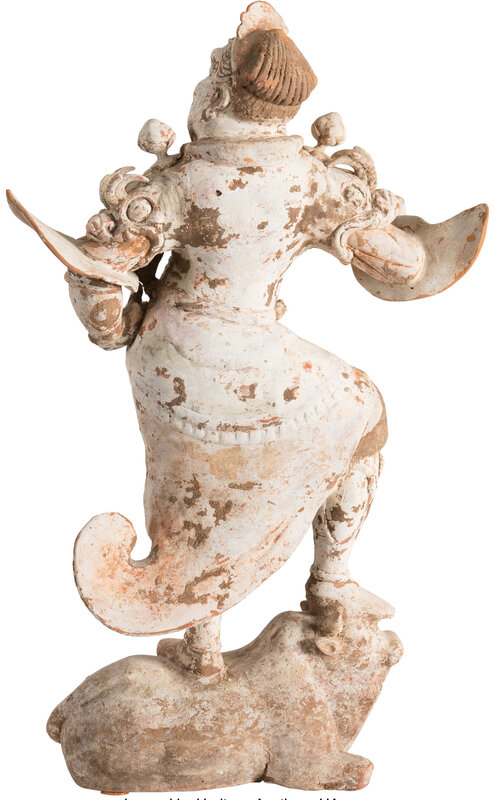Carved limestone from ancient Chinese caves could reach $60,000 in Heritage Asian Art Auction
DALLAS, TX.- A beautiful carved limestone figure from a wall fragment in the Longmen Caves in Henan province could bring $60,000 or more in Heritage Auctions' Fine & Decorative Asian Art Auction Dec. 11.
"We are proudly presenting a variety of fine and decorative Asian works of art, including snuff bottles, jade carvings, fine dynastic ceramics, important paintings and calligraphy etc.," Heritage Auctions Asian Art Consignment Director Moyun Niu said. "This auction also features a group of scholar's objects, from naturally sculpted Suzhou scholar's rocks to exquisitely carved Zitan brushpots."
A Chinese Carved Limestone Seated Figure of Maitreya Buddha, Longmen Grottoes, Luoyang, Henan Province, Northern Wei Dynasty (estimate: $40,000-60,000) originally was part of a wall fragment south of Luoyang, where it has been suggested that related examples would have stood in niches along the northern wall of the Guiyang cave. Figures such as the offered example are identified as Maitreya Buddha, the successor of the historic Sakyamuni Buddha. A very similar example is found in the Museum Rietberg, Zurich, as illustrated by O. Sirén, Chinese Sculptures in the von der Heydt Collection, Zurich, 1959, Catalogue no. 11. Another depiction of Maitreya Buddha from Longmen is in the collection of the Albright-Knox Art Gallery, Buffalo, New York. The offered lot was purchased from Mathias Komor, who was the leading dealer in Chinese art in New York in the post-war period and assisted in the formation of major institutional and private collections.
Lot 67083. A Chinese Carved Limestone Seated Figure of Maitreya Buddha, Longmen Grottoes, Luoyang, Henan Province, Northern Wei Dynasty; 17-1/2 x 10-3/4 x 2 inches (44.5 x 27.3 x 5.1 cm). Estimate: $40,000 - $60,000. Courtesy Heritage Auctions.
Marks: Paper label verso MATHIAS KOMOR, CHINESE ART, NEW YORK, C46, (various).
Provenance: Christie's, New York, September 21, 2000, lot 188;
Mathias Komor, New York, Chinese Art, lot C46;
North American university collection.
Note: The figure deftly carved seated with legs crossed at the ankles, the folds of the thin dhoti cascading down the edge of the base and its legs in a series of rhythmic folds, slender torso with tapered waist, the elongated earlobes and the tall flaring crown framing the slightly bulging eyes gazing down in contemplation below arched brows issuing from the curve of the broad nose, all above the full lips drawn in a tender smile. The grey stone was originally part of a wall fragment in the Longmen caves, located south of Luoyang in Henan province, where it has been suggested that related examples would have stood in niches along the northern wall of the Guyang cave. Figures such as the present example, are identified as Maitreya Buddha, the successor of the historic Sakyamuni Buddha. A very similar example of Maitreya Buddha seated with ankles crossed and with the left hand resting on a guardian lion is found in the Museum Rietberg, Zurich, as illustrated by O. Sirén, Chinese Sculptures in the von der Heydt Collection, Zurich, 1959, Catalogue no. 11. Another depiction of Maitreya Buddha from Longmen, similarly seated but cradling its cheek in a pensive posture, in the collection of the Albright-Knox Art Gallery, Buffalo, New York, was illustrated by Andrew C. Ritchie, Catalogue of the Paintings and Sculpture in the Permanent Collection, Albright Art Gallery, Buffalo, 1949, p. 212, no. 209. It was subsequently sold at Sotheby's New York, March 20 2007, lot 503, alongside the renowned archaic bronze fangjia (lot 507). As with the current lot, the fangjia was also purchased from Mathias Komor who was the leading dealer in Chinese art in New York in the post-war period and assisted in the formation of major institutional and private collections.
A Pair of Chinese Painted and Gilded Pottery Lokapala, Tang Dynasty (estimate: $30,000-50,000) depicts a pair of figures, each standing straight up on a shaped base, with fierce face expressions and bent arms; each wearing elaborately decorated armors with dragon motifs under long robes, the armors and robes picked out in orange and green pigment, and the armors richly gilded. The result of Oxford thermoluminescence tests is consistent with the dating of this lot.
Lot 67084. A Pair of Chinese Painted and Gilded Pottery Lokapala, Tang Dynasty; 28-3/8 inches (72 cm) (each). Estimate: $30,000 - $50,000. Courtesy Heritage Auctions.
Each powerfully modeled, standing straight on a shaped base, each with fierce face expression and bent arms; each wearing elaborately decorated armors with dragon motifs under long robes, the armors and robes picked out in orange and green pigment, and the armors richly gilded.
Together with Oxford Authentication Ltd. Certificates. The result of Oxford thermoluminescence tests no. C177f74 and C177f75 is consistent with the dating of this lot.
A Tibetan Gilt Bronze Figure of Vajrapani, 14th century (estimate: $30,000-40,000) is a magnificent representation of one of the earliest-appearing bodhisattvas in Mahayana Buddhism. Vajrapani is extensively represented in Buddhist iconography as one of the earliest three protective deities or bodhisattvas surrounding the Buddha. The bronze figure, with inset gemstones, stands 5-1/8 inches tall.
Lot 67312. A Tibetan Gilt Bronze Figure of Vajrapani, 14th century; 5-1/8 x 3-1/2 x 2 inches (13.0 x 8.9 x 5.1 cm). Estimate: $30,000 - $40,000. Courtesy Heritage Auctions.
A Chinese Jade and Hardstone-Inlaid Wood Six-Panel Screen, Qing Dynasty, 19th century (estimate: $20,000-30,000) is an exceptional screen that stands more than 5 feet (62 inches) high and stretches 114 inches long. Each panel is divided into three sections, the central and bottom sections embellished with carved animals and flowering branches, all applied with various hardstones, jade, coral, turquoise and lapis lazuli, the top section with inscription and various seals of Zheng Banqiao (1693-1766).
Lot 67201. A Chinese Jade and Hardstone-Inlaid Wood Six-Panel Screen, Qing Dynasty, 19th century; 62 x 114 inches (157.5 x 289.6 cm). Estimate: $20,000 - $30,000. Courtesy Heritage Auctions.
Each panel divided into three sections, the central and bottom sections embellished with carved animals and flowering branches, all applied with various hardstones, jade, coral, turquoise, lapis lazuli, the top section with inscription and various seals of Zheng Banqiao (1693-1766).
Other top lots include, but are not limited to:
Lot 67124. A Chinese Flambé Glazed Vase, Six-character Daoguang mark and of the period; 11-3/4 x 7-3/4 x 5-5/8 inches (29.8 x 19.7 x 14.3 cm). Estimate: $20,000-30,000. Courtesy Heritage Auctions.
Lot 67089. A Pair of Chinese painted pottery Lokapalas, Tang Dynasty. Estimate: $15,000 - $25,000. Courtesy Heritage Auctions.
Each standing in powerful pose and in ornate armor, each standing atop a recumbent bull with one foot on its head and the other on its rump; with much remaining original pigments. The result of Oxford thermoluminescence test no. C198t8 is consistent with the dating of this lot.
Provenance: Battledore Ltd., New York.
Lot 67118. A Chinese Blue and White Lotus Vase, Tianqiuping, Qing Dynasty, 18th century; 24 x 13 inches (61.0 x 33.0 cm). Estimate: $15,000-20,000. Courtesy Heritage Auctions.
Lot 67295. Qian Du (Chinese, 1763-1844), Making Pills of Immortality under Tree Shades, 1835. Ink on silk scroll, 33-1/2 x 10-3/4 inches (85.1 x 27.3 cm) (work), 81 x 18-1/2 inches (205.7 x 46.9 (overall), Three red seals. Estimate: $12,000-18,000. Courtesy Heritage Auctions.
Ink and color on silk hanging scroll, depicting figures under tree shades, signed Qian Shumei, dated yiwei (1835), with one seal of the artist, hu gong and three collectors' seals; in wood box.
Provenance: Sotheby's, New York, Fine Classical Chinese Paintings, September 13, 2012, lot 660.
Lot 67104. A Chinese Tobi Seiji Decorated Longquan Celadon Covered Jar, Yuan Dynasty, 14th century; 3-1/2 x 4-1/2 inches (8.9 x 11.4 cm). Estimate: $10,000-20,000. Courtesy Heritage Auctions.
Provenance: Collection of a German Consular Officer in China (1902-1917 and 1920-1930);
Thence by descent.
Reference: Sekai Toji Zenshu (Ceramic Art of the World). Vol. 12, Tokyo, 1977, p. 85-86.
New York. The Metropolitan Museum of Art. "The Yuan Revolution: Art and Dynastic Change," August 21, 2010-January 9, 2011.
Boston. The Museum of Fine Arts, Lonquan Celadon Jar, Loan no. M.F.A. 51.47a.
New York. The Metropolitan Museum of Art. Jar with Peony Scroll, Yuan Dynasty (14th century), Accession no. 34.113.6a, b.
New York. The Metropolitan Museum of Art. Vase with Peony Scrolls, Yuan Dynasty (mid-14th century), Accession no. 26.292.77.
Note: The term tobi seiji is a Japanese term meaning "flying celadon" and refers to wares made around the Longquan kilns in the Zhejiang province of China during the Yuan Dynasty (1271-1368). The nomenclature of "Longquan" to Chinese ceramics is not applied in reference to a specific kiln site, rather it derives from the name of the market town where these ceramics were offered for sale. The techniques used to produce celadons were inherited from the Yue kilns, which produced wares in the same province during the Northern Song Dynasty (960-1127.)
After the capture of the Song capital at Bianliang around 1125, the court relocated to Hangzhou and formed the Southern Song Dynasty (1127-1279.) The Southern Song court encouraged a highly aestheticized lifestyle, and fine and decorative art evoked romanticized and poetic ideals. As a result, Longquan celadon wares experienced a generous patronage, celebrated for the quality of materials, variety of forms, and pleasing translucent glazes. As the Yuan Dynasty progressed, growing popularity and demand for celadon merchandise was accommodated by a surge of nearly 300 kilns. Strategically placed near sources of clay and water, the kilns facilitated the sale and transport of celadon works not only in China, but to lucrative export markets in Japan and Turkey.
The presence of iron oxide spotting is a signature technique of the Longquan kilns, and appears on works produced during the thirteenth and fourteenth centuries. The brown spotted decoration was a departure from traditional monochromatic celadon glazes, however this thoughtful design element provides another layer of dimensionality: it interrupts the green ground and accentuates the molded decoration, drawing the eye to focus on the separate parts which make the whole.
Though tobi seiji decorated Longquan vases are rare, complete boxes such as the present example are virtually unknown. The crisply molded peonies are a typical motif found on molded Longquan works from this period, however the three-toed dragon chasing pearl (or pi-disc) and five-pointed star borders position the piece as a superior example in well-preserved and unrestored condition.
Lot 67284. Chinese School (18th-19th century), Procession of Wang Zhaojun. Handscroll, ink and color on silk, 9-3/4 x 138-1/2 inches (24.8 x 351.8 cm). Bearing six red seals. Estimate: $10,000-15,000. Courtesy Heritage Auctions.
The handscroll with an ink and color on silk painting depicting horses and riders, accompanied by two ink on paper calligraphic works, bearing the signature of Ru Wenshu, with two colophons bearing the signatures of Wang Baigu and Chen Jiru.

/https%3A%2F%2Fprofilepics.canalblog.com%2Fprofilepics%2F1%2F0%2F100183.jpg)
/https%3A%2F%2Fstorage.canalblog.com%2F03%2F02%2F119589%2F96711876_o.jpg)
/https%3A%2F%2Fstorage.canalblog.com%2F11%2F31%2F119589%2F94773502_o.jpg)
/https%3A%2F%2Fstorage.canalblog.com%2F20%2F83%2F119589%2F94772815_o.jpg)
/https%3A%2F%2Fstorage.canalblog.com%2F26%2F72%2F119589%2F75604929_o.jpg)
/https%3A%2F%2Fstorage.canalblog.com%2F59%2F60%2F119589%2F26458628_o.jpg)


































/http%3A%2F%2Fstorage.canalblog.com%2F70%2F68%2F119589%2F129847829_o.jpg)
/http%3A%2F%2Fstorage.canalblog.com%2F73%2F24%2F119589%2F129777876_o.jpg)
/http%3A%2F%2Fstorage.canalblog.com%2F21%2F76%2F119589%2F129705240_o.jpg)
/http%3A%2F%2Fstorage.canalblog.com%2F43%2F93%2F119589%2F129481804_o.jpg)